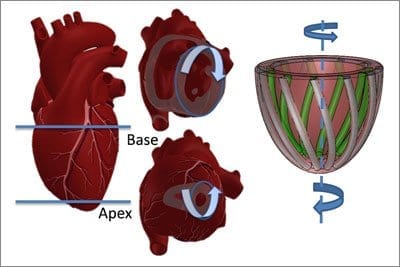
“It could inspire a whole new class of cardiac therapies, such as improved ventricular assist devices that mimic natural heart motion.”
In the heart, as in the movies, 3D action beats the 2D experience hands down.
In 3D, healthy hearts do their own version of the twist. Rather than a simple pumping action, they circulate blood as if they were wringing a towel. The bottom of the heart twists as it contracts in a counterclockwise direction while the top twists clockwise. Scientists call this the left ventricular twist—and it can be used as an indicator of heart health.
The heart is not alone. The human body is replete with examples of soft muscular systems that bend, twist, extend, and flex in complex ways. Engineers have long sought to design robotic systems with the requisite actuation systems that can perform similar tasks, but these have fallen short.
Now a team of researchers at Harvard’s Wyss Institute for Biologically Inspired Engineering and Harvard’s School of Engineering and Applied Sciences (SEAS) has developed a low-cost, programmable soft actuated material that gives renewed hope to the mission. They demonstrated the material’s potential by using it to replicate the biological motion of the heart, and also developed a matching 3D computer model of it, as reported in Advanced Materials.
“Most models of the heart used today do not mimic its 3D motion,” said lead author Ellen Roche, an M.D./Ph.D. candidate at SEAS who is also affiliated with the Wyss Institute. “They only take flow into account.”
What’s missing is the essential twisting motion that the heart uses to pump blood efficiently.
“We drew our inspiration for the soft actuated material from the elegant design of the heart,” said Wyss Core Faculty member Conor Walsh, Ph.D., the senior author, who is also an Assistant Professor of Mechanical and Biomedical Engineering at SEAS and founder of the Harvard Biodesign Lab. “This approach could inspire better surgical training tools and implantable heart devices, and opens new possibilities in the emerging field of soft robotics for devices that assist other organs as well.”
The heart moves the way it does because of its bundles of striated muscle fibers, which are oriented spirally in the same direction and work together to effect motion.
The Latest on: Soft Robotics
[google_news title=”” keyword=”Soft Robotics” num_posts=”10″ blurb_length=”0″ show_thumb=”left”]
via Google News
The Latest on: Soft Robotics
- Spot vs furry Sparkles: Watch Boston Dynamics’ robot dogs dance offon May 1, 2024 at 5:32 am
Boston Dynamics’ Spot now has a furry cousin, Sparkles, and this cuddly canine will surely melt hearts. In a recently released video, the company showcased Sparkles along with the robot dog Spot, and ...
- A miniature wireless robot that can effectively move through tubular structureson May 1, 2024 at 3:50 am
Robots have already proved to be promising tools to complete complex and demanding maintenance tasks. While engineers have developed a wide range of robots that could help to maintain and repair ...
- CMU Researchers and Robots Shine at Robotics Showcase in Nation’s Capitalon April 30, 2024 at 7:48 pm
Carnegie Mellon University researchers from its Robotics Institute(opens in new window) (RI) and College of Engineering(opens in new window) are packing up fossil-inspired paleobionics(opens in new ...
- Dyson just launched a robot vacuum — snag one before they sell outon April 29, 2024 at 9:41 am
As a lover and major tester of vacuums, I’m beyond excited about the launch of Dyson’s latest robot vacuum with a host of new technology. Dyson claims this is “the most powerful robot with twice the ...
- A touch of genius. How to make soft and squishy robotson April 28, 2024 at 4:14 am
The major challenge to robots becoming more human-like is the skin and the sense of touch, and responses to it. The complexity of design in creating human-like skin for robots is enormous: ...
- Soft robotic nerve cuffs could revolutionize treatment of neurological conditionson April 26, 2024 at 5:49 pm
Researchers have developed tiny, flexible devices that can wrap around individual nerve fibres without damaging them.
- Video of super-fast, super-smooth humanoid robot will drop your jawon April 26, 2024 at 3:51 am
While it seems that another humanoid robot is being released every week, we've yet to see one move as quickly or with as much precision as the model just released by Chinese company, Astribot. We dare ...
- This robot can predict a smile before it happenson April 24, 2024 at 11:17 am
STORY: This AI-integrated robotic face can predict a smile before it happens.It's called Emo and it can anticipate and mimic human facial expressions.Engineers at Columbia University’s Creative ...
- 3D Printed Soft Skin Pads Offer Enhanced Safety and Usability in Roboticson April 23, 2024 at 9:00 am
Researchers at the University of Illinois have leveraged 3D printing to develop soft skin pads to enhance safety and usability in robotics.
- How 3D printers can give robots a soft touchon April 17, 2024 at 2:36 pm
Soft skin coverings and touch sensors have emerged as a promising feature for robots that are both safer and more intuitive for human interaction, but they are expensive and difficult to make. A ...
via Bing News









